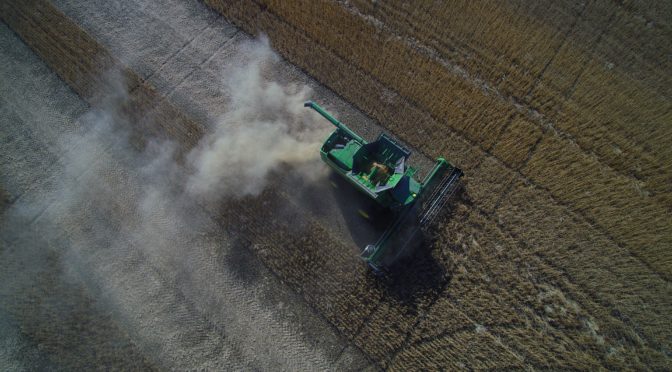So last year I had the chance to do some work on my Uncle’s farm again (first time in years) and it so happened that he had a new-ish drone in his possession. He actually had two, but he crashed the first one, then his son-in-law crashed another, and so the drone that I actually got a chance to use was his third. And use it I did.
The model my Uncle had was a Yuneec Typhoon Q500+ 4K. The first model was white and the model I used was black. Four propellers, a 4K camera one a gimbal and two landing feet. The battery was probably the heaviest part and was good for about 15 minutes of flight time.
Here’s a pic of our little drone:
New toy, or new skill? #drone #video #aerialphotography #photo #Travel #dontcrash
As exciting as it was to have this thing under my control I can’t say it was very calming to fly. As a matter of fact, the experience was more tense and nerve-wracking then the promotional materials had me believe. You’ll note that all of the propellers are black in the photo above but that would change as I, too, would, ermmm, crash the thing a couple of times.
But here are my impressions of using the thing:
The first thing you notice is the propellers. Our model had four propellers, made of plastic (as was most of the body) so the thing could be relatively light-weight. The placement of the propellers and the fact that they were “open” to the air (and to your fingers) meant that it was both kinda unwieldy and, in my opinion, kinda dangerous. The idea of cutting one of my fingers off became even more real the first time my Uncle fired the thing up. These things don’t sound like a gentle breeze through the grass but instead sound like a swarm of bees. And that’s just in pre-flight mode. Once you engage the actual flight mechanism the propellers sound like an angry swarm of bees. Not too welcoming, to say the least.
Even before you get to flying the thing, however, you need to calibrate and set it up. This sounds like a no brainer but when you turn the machine on, it starts to blink a bunch of different colours and, even more confusingly, blinks in certain patterns. You can “read” these colours and patterns but first you need to watch and then consult the included instruction card. In total there are about 16 different patterns. Yeha… I can guess your reaction was like mine. WTF do all these blinking lights mean? Was that calibration? Error? Feed me? Kinda confusing to say the least.
But, all that being done, once the machine has been started, calibrated, GPS satellites connected and the angry swarm of propeller-bees gets up in the air, you now have to control the thing. There are four settings to control the drone but don’t ask me for specifics because I really just thought they would be labelled “up/down” and “side to side”. Those labels, if you think about it, don’t really apply to flying because flying takes place in three ways, not two (like cars and tractors). Instead, they have labels like “Elevator/Pitch Control” (for moving up and down) and “Aileron/Roll Control” (for moving side to side). I just wanted to know up, down, side to side and to be able to move the camera. I can say that once you get the hang of the controls, it’s pretty fun to be able to move things around, especially with the camera recording.
Second, they are easy to crash. As my Uncle demonstrated with his initial training session for me, not knowing how the controls work can cause the thing to move in a way you don’t want and, well, whoopsies. So the drone went down. Luckily we only lost a few propellers that time ($11 each) and no one got hurt. It’s not like the thing didn’t come with warnings. They do. The user manual itself shows and states not to fly near buildings, trees or other tall objects, don’t fly over crowds, nor should you fly in winds exceeding 13-19 kms/h. And don’t put your fingers or hands anywhere near the moving propellers. So you can’t say you aren’t warned.
But the warnings are just words and pictures on a page so until you actually fly the thing you can’t really grasp why these warnings matter. Again, back to the angry swarm of bee-propellers, they sound nasty and dangerous. Seriously, don’t put your finger anywhere near those things! Second, since the propellers are made of plastic they are extraordinarily delicate which means even if you think you’re far enough from a tree itself, if a gust of wind catches it and the drone clips a twig or a leaf, down goes your drone. Hopefully you’re not too far off of the ground because when these things crash land they really do more of the crashing than the landing. If you’re lucky (like we were the first time) you might lose a few propellers. But if you’re unlucky like the first two drones, then you lose the camera ($300) or more (the whole thing… $1200), except maybe the battery ($100).
So you do need to be careful.
But I did manage to get the thing up in the air and not crash and so could capture a few shots of the farm. I used the “Follow Me” mode at first just to get a hang of it and then moved on to manual control after a few test flights.
Manual isn’t difficult to use provided that you don’t try to fly between trees or buildings (or near combines) on a windy day (or on a low battery). If you do, you’ll most likely regret it. What I do recommend you do (especially if you’re new to flying a drone) is to get the drone up into the air and then practice moving the camera and propellers from side to side. Once you get familiar with how you can move the drone and the camera at the same time, you’ll be able to bring the drone down a bit closer to earth for some fly-bys or close ups. There is no zoom on the camera we used so you’re locked into a wide shot. It’s great for landscapes but if you want to get some detail into your shots that will mean getting closer to your object and watching not only the camera (if you want to pan at all) but the object and anything around it because of the aforementioned wind warnings. Or power lines. Don’t hit those either.
By now you’re probably wondering what the shots looked like.
The camera took alright pictures while the video was apparently shot at 4K. Here are a few of the stills:
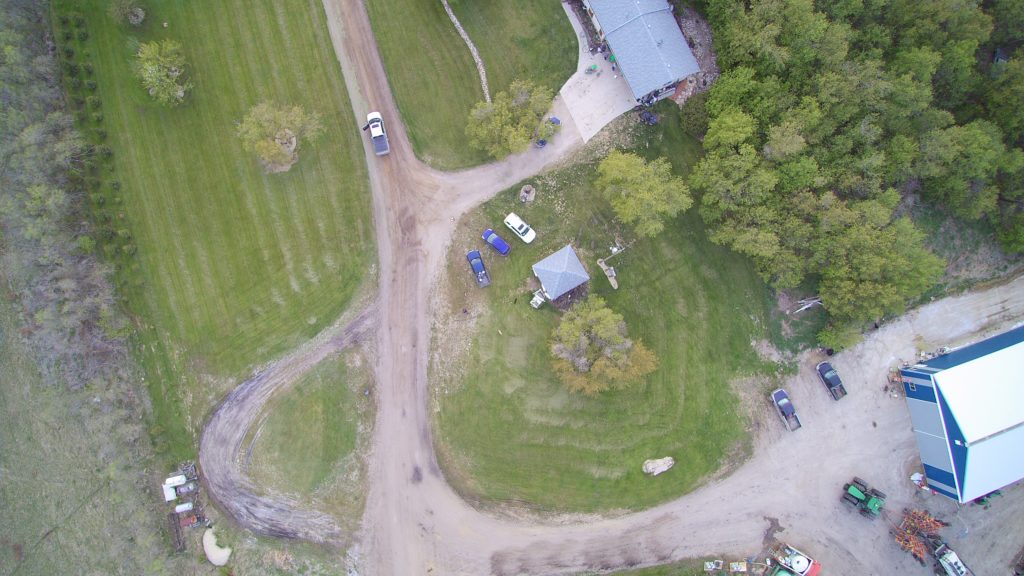
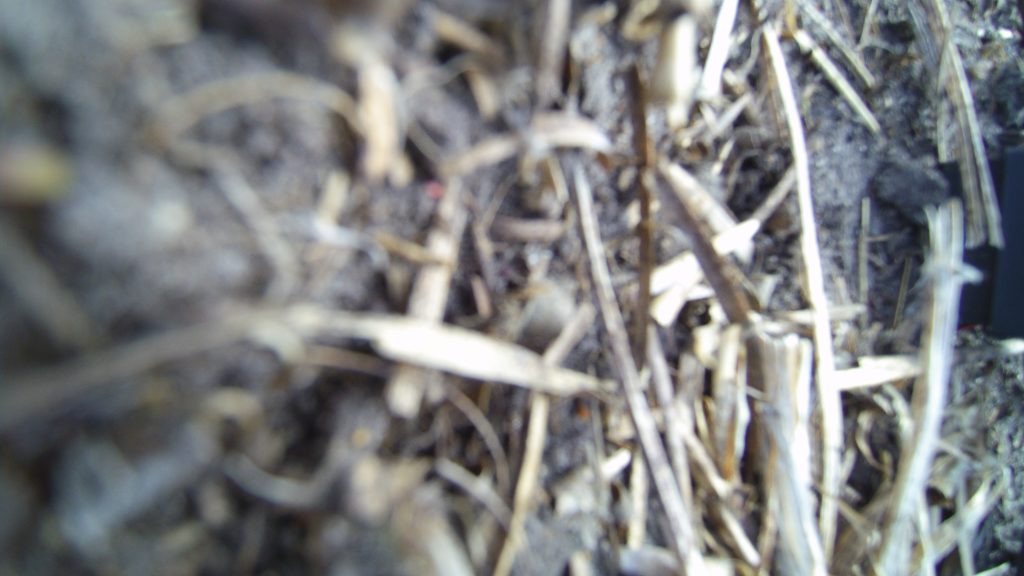
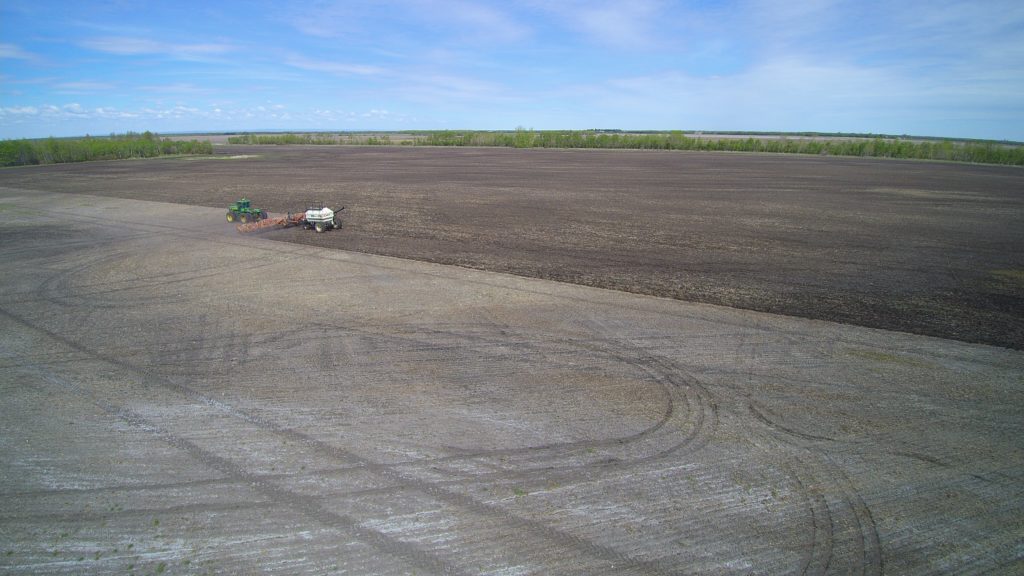
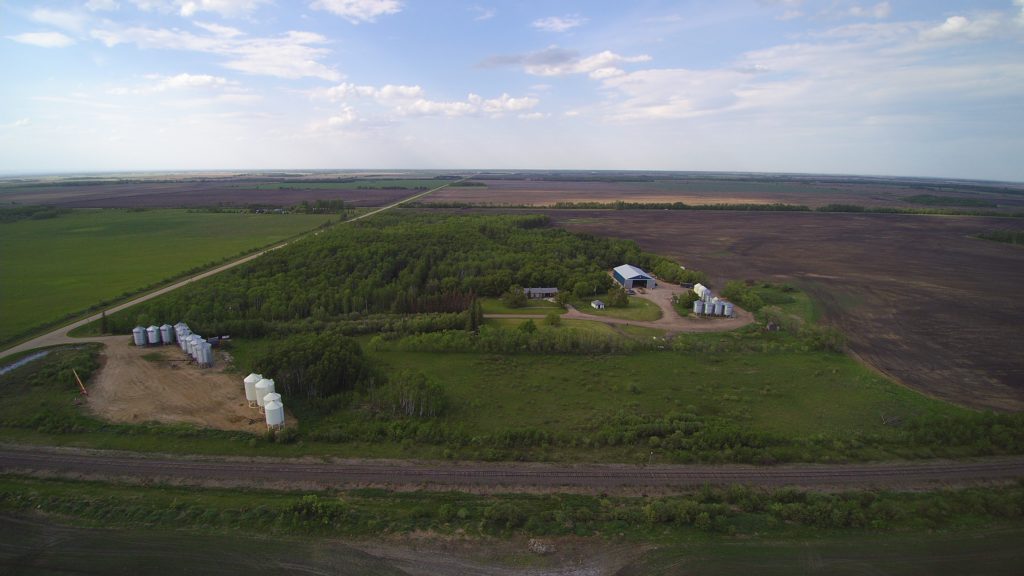
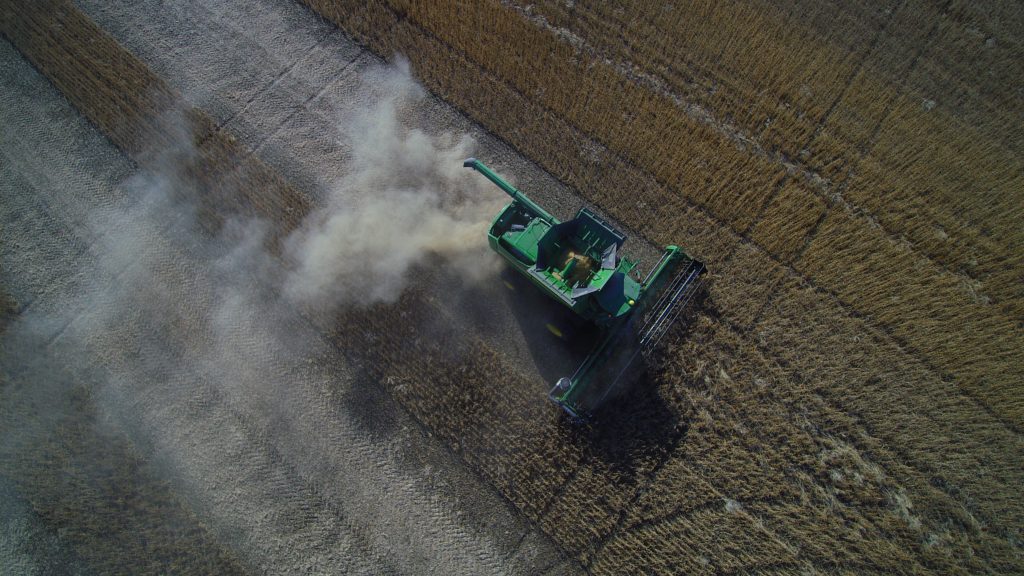
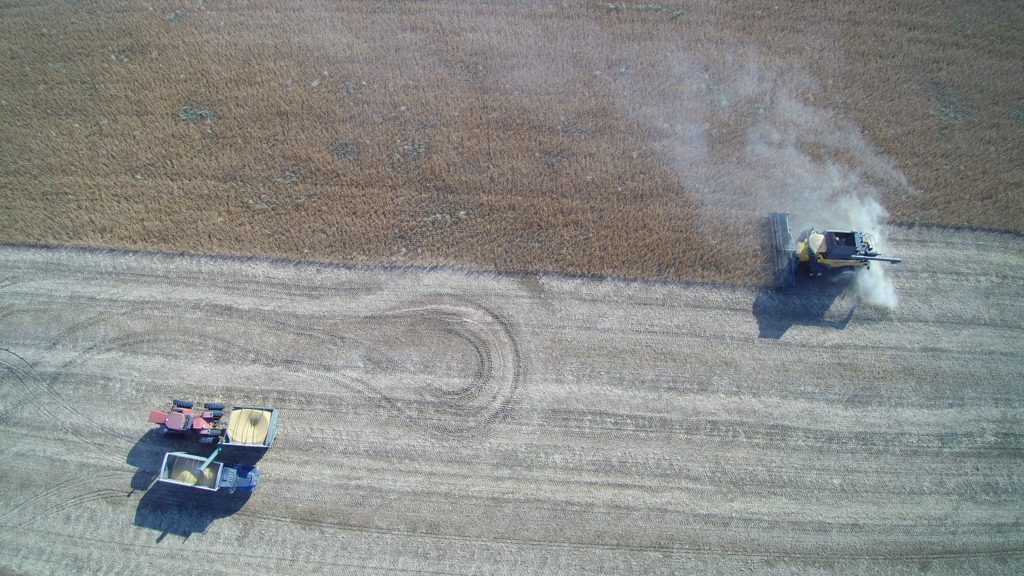
For those who are interested in the raw footage, I’ve posted some of the videos on YouTube and provided the links below. For those of you who want a simpler, more interesting, best of montage… you’ll have to wait just a wee bit longer as I get the final video assembled. Anyway, for those of you who are interested, here are some of the shots:
**Note: there is NO SOUND for these videos!
This is what happens when your drone isn’t calibrated properly:
Here’s a shot of a truck being filled by a grain cart as two combines harvest the crop:
The one bad thing about the camera is that I couldn’t take photos while the video camera was engaged, a feature that has become so common in many other digital cameras. Here’s a continuation of that same shot but with a bit of a combine fly-over:
And then here is another attempt at a fly-over with okay results:
And this one I’m pretty proud of because I do get the drone pretty close to the ground. As you watch, the moving video really does pull you into it and makes you kinda tense as if you’re about to crash. But I don’t! 😉
So, Steve, did you ever crash the thing?
Hahahahaaaaaaa….. yea, I did. On my LAST DAY of the job I was making the above videos when the battery started flashing. If gave me the first warning to land, I kinda ignored it (You should land right now). Then it gave me the second warning (LAND! Like really quickly!) and I got thinking I’d just fly the thing to the edge of the field so I could capture a shot of the combine coming near it. Then the third, and final, warning appeared (I’m landing, you dummy, I’m outta juice!) and then, as the combine approached, the drone descended aaaaand… BONK! off of the header the drone went. The combine stopped (so the guy could figure out what he hit since he was driving into the sun) and then there went the drone. Oops. Here is the last shot I got before the drone went down:
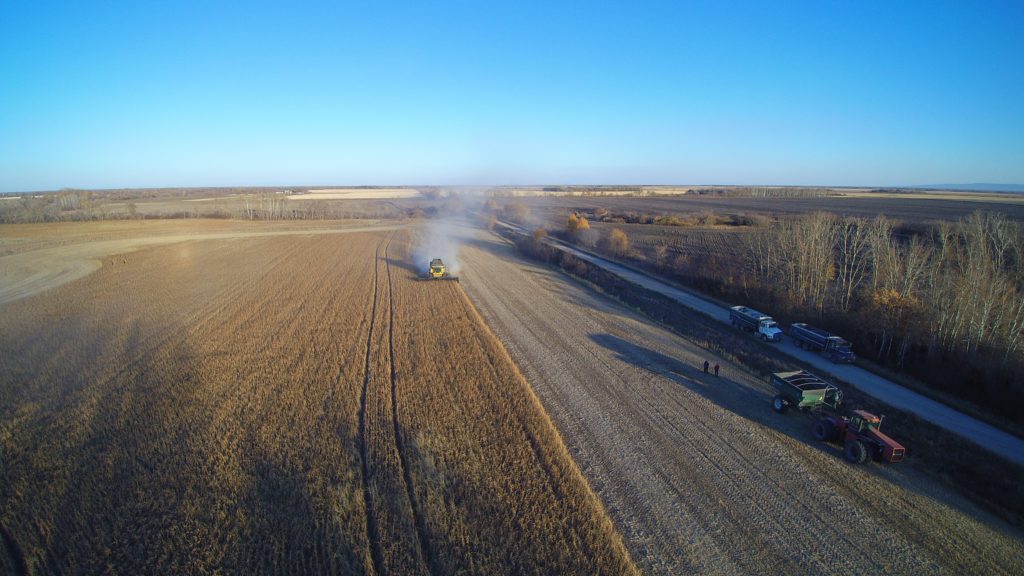
So let that be one last piece of advice: when the drone tells you to land, you should land!
